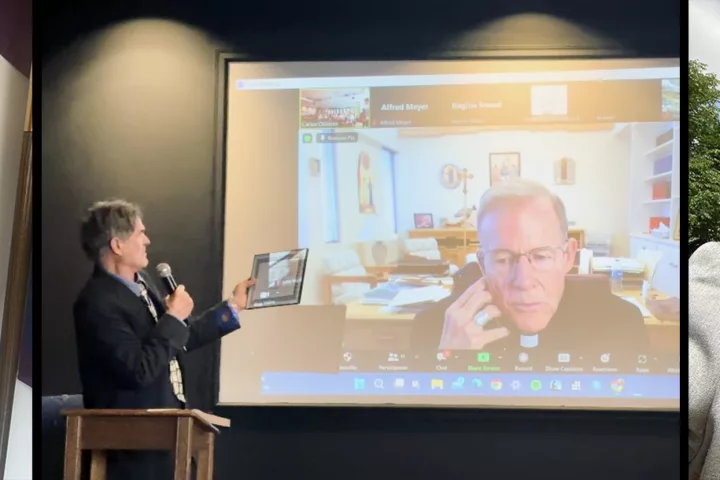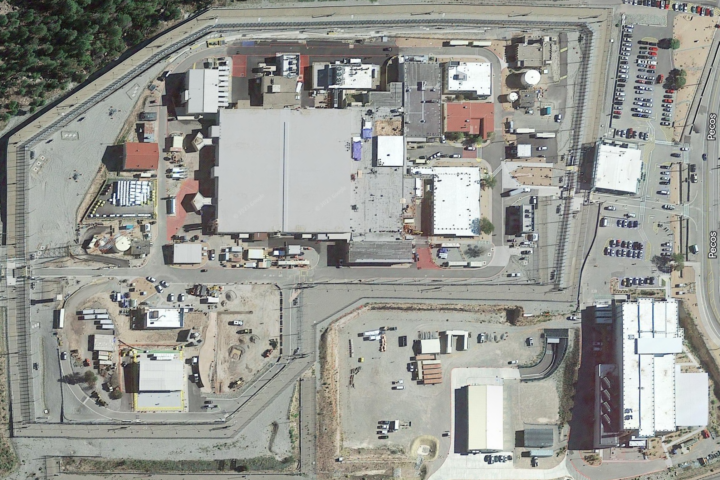As part of a long, ingrained history, senior officials at the New Mexico Environment Department (NMED) have repeatedly resigned to go to work for the nuclear weapons labs, the Department of Energy, or DOE contractors. In a number of cases that is where they came from to begin with.
The hierarchy of leadership at NMED starts with the Secretary, Deputy Secretaries and then Division Directors. The position of Resource Protection Division Director is particularly critical because it oversees the two NMED bureaus most directly involved with DOE facilities in New Mexico, the Hazardous Waste Bureau and the DOE Oversight Bureau.
FULL PRESS RELEASE [PDF]
However, all four former or current Resource Protection Division Directors have gone or are going to work for the nuclear weapons labs, the DOE or its contractors. They are:
- Chris Catechis, currently Acting Resource Protection Division Director, is reportedly assuming a job at the Los Alamos National Laboratory (LANL) within days. Prior to NMED he had worked at the Sandia National Laboratories for 22 years.[1]
- Catechis’ immediate supervisor Stephanie Stringer resigned October 31 to go to work for DOE’s semi-autonomous nuclear weapons agency, the National Nuclear Security Administration (NNSA). She was Resource Protection Division Director prior to being promoted to Deputy Cabinet Secretary for Operations (second only to NMED Secretary James Kenney).
- J.C. Borrego resigned as NMED Acting Deputy Secretary and Acting Resource Protection Division Director in the last months of the Governor Martinez Administration to go to work for the Sandia National Laboratories.
- During the Martinez Administration, Kathryn Roberts resigned as Resource Protection Division Director to go to work for a DOE contractor. Prior to NMED she had worked at LANL for four years as Group Leader for Regulatory Support and Performance.
This begs the question of whether the positions of NMED Deputy Directors and Resource Protection Division Directors are being intentionally targeted for co-optation by the nuclear weapons industry. The Environment Department remains underfunded and understaffed, but in contrast DOE will spend $9.4 billion in FY 2023 on nuclear weapons and related programs in New Mexico. [2] This is astonishing when the state’s entire operating budget is $8.5 billion. Exactly what the benefits are for New Mexicans from all of this nuclear weapons spending is not clear. On the downside, the Land of Enchantment is a target for nuclear waste dumping. At the same time, New Mexico is rated dead last in education[3] and quality of life for children.[4]
DOE’s largest expenditures in New Mexico are for the aggressive expansion of the production of plutonium “pits,” the radioactive cores of nuclear weapons. This will generate yet more radioactive wastes and contamination that should require robust regulation and enforcement. Despite that, top NMED officials are subverting their loyalties during an ongoing lawsuit by the Environment Department against DOE seeking to terminate a 2016 “Consent Order” that condones weak cleanup at the Lab.
The Deputy Directors and the Resource Protection Division Directors serve at the pleasure of the Governor. Yet their actions seemingly conflict with a “Code of Conduct” that Governor Michelle Lujan Grisham stipulated for state employees. It decreed:
“You shall treat your government position as a public trust… only to advance the public interest and not to obtain personal benefits… Full disclosure of real or potential conflicts of interest shall be a guiding principle… You shall not engage in any other employment or activity that creates a conflict of interest… you shall disclose any anticipated outside employment before it begins… violating some provisions of this Code of Conduct may subject you to potential civil enforcement actions and criminal penalties under the law.”[5]
To illustrate how these changing loyalties can potentially compromise environmental protection in New Mexico, Stringer and Catechis were centrally involved in recent and pending NMED decisions on:
- Granting “temporary authorization” to the Waste Isolation Pilot Plant (WIPP), the nation’s only designated permanent radioactive waste dump, to drill a new ventilation shaft to support its expansion.
- Extending WIPP’s hazardous waste permit. The current permit expired in 2020 but has been administratively continued. DOE is now seeking to have it indefinitely extended. More than half of WIPP’s future capacity will be reserved for plutonium wastes from expanded nuclear weapons production.
- Allowing or not allowing LANL to release up to 100,000 curies of gaseous radioactive tritium into the air.
- Approving or not LANL’s request to “cap and cover” existing buried radioactive and toxic wastes, instead of comprehensive cleanup that would eliminate the threat to groundwater.
- NMED’s lawsuit against DOE to terminate the ineffective 2016 Consent Order governing cleanup at LANL.
NMED Deputy Secretary Stephanie Stringer doubled as Chair of New Mexico’s Water Quality Control Commission (WQCC). She recently opposed a motion by the citizen groups Concerned Citizens for Nuclear Safety (CCNS) and Honor Our Pueblo Existence to reverse a state groundwater discharge permit. CCNS’ Joni Arends questioned Stringer’s decision, saying, “The important LANL Radioactive Liquid Waste Treatment Facility (RLWTF) handles, treats and stores hazardous wastes, hence it is required to be regulated by the NM Hazardous Waste Act. But under her leadership, the Water Quality Control Commission rejected our petition for review of the permit on jurisdictional grounds, while granting a stay of the proceedings as requested by NNSA.”
“We learned that Stringer submitted her job application to NNSA on August 7, two days before a WQCC hearing that she presided over as Chair. On August 30, she signed the Commission’s order granting the NNSA’s motion to stay all proceedings on the RLWTF. The very next day NNSA offered Stringer a salaried position. On October 31, 2022, Stringer resigned her position with NMED and on November 6 reported for work with NNSA. At no time did Stephanie Stringer disclose her new job before leaving NMED. Her conduct disqualified her from serving on the WQCC and is highly improper and in violation of the Governor’s Code of Conduct – all to the detriment of the citizens and environment of New Mexico.”[6]
The example of former Resource Protection Division Director Kathryn Roberts is particularly troubling. After working at LANL she was employed at NMED and in time became the Resource Protection Division Director. In that capacity she was the lead negotiator with Christine Gelles, then-manager of the DOE Environmental Management Los Alamos field office, for a revised 2016 Consent Order that weakened cleanup at LANL. Roberts resigned from NMED a half year after the revised Order went into effect, joining Gelles at Locknecker and Associates, a LANL cleanup contractor.[7] The new Consent Order allowed the Lab to settle any outstanding violations of the more stringent and enforceable 2005 Consent Order. Existing violations were waived when New Mexico could have collected more than $300 million in stipulated penalties had NMED vigorously enforced the 2005 Consent Order. At the time, the Land of Enchantment was facing a budget crisis with a projected $600 million deficit. In effect, NMED gave away half of that deficit to a polluting nuclear weapons site that now has an annual budget of $4.5 billion.
Other examples of NMED’s revolving door of regulators selling out to the regulated:
- Katheryn Robert’s immediate boss at the time, NMED Secretary Ryan Flynn, resigned to become executive director of the New Mexico Oil and Gas Association that lobbies against environmental regulations. He is now Director of Water Programs at Sealaska, a subcontractor to N3B on water compliance issues at LANL.
- In the 1990’s, after drafting state regulations governing the release of mixed radioactive and hazardous air emissions, NMED air quality specialist Bill Blankenship left to work at LANL, in part to enable a Clean Air Act permit for a major plutonium facility for nuclear weapons.
- Pete Maggiore, NMED Secretary July 1998 – August 2002, joined NNSA’s Los Alamos Office in 2011.
- Susan McMichael, NMED Office of General Counsel in the late 1990’s, resigned to become an attorney for LANL.
- Kathryn Lynnes, Environmental Compliance Specialist, Hazardous Waste Bureau 2004 – 2006, subsequently worked for LANL and then for the Air Force on the Kirtland Air Force Base’s aviation fuel spill that contaminated Albuquerque’s groundwater, a very contentious issue for the State of New Mexico.
Bottom line: New Mexico needs to quit being a nuclear banana republic. We can’t have our top Environment Department officials selling out to the state’s largest polluters. Governor Michelle Lujan Grisham should enforce the Code of Conduct that she stipulated. Moreover, state legislators should pass a law that the regulators can’t go to work for the regulated for at least two years after leaving their positions with the New Mexico Environment Department.
Jay Coghlan
Nuclear Watch New Mexico
www.nukewatch.org
[1] See https://www.linkedin.com/in/chris-catechis-ma-b76b1a8/
[2] The Department of Energy will spend $9.4 billion in New Mexico in FY 2023, 71% for core nuclear weapons research and production programs, while much of the remainder is for dumping radioactive wastes. See State Table, DOE FY 2023 Congressional Budget Request, p. 52, at https://www.energy.gov/sites/default/files/2022-04/doe-fy-23-budget-state-table.pdf In contrast, the State of New Mexico’s entire operating budget for FY 2023 is $8.5 billion.
[3] Best States for Education 2022, https://worldpopulationreview.com/state-rankings/best-states-for-education
[4] 2022 KIDS COUNT Data Book, Annie E. Casey Foundation, https://assets.aecf.org/m/resourcedoc/aecf-2022kidscountdatabook-2022.pdf, page 19.
[5] Code of Conduct, New Mexico Governor Michelle Lujan Grisham, July 2019, https://www.spo.state.nm.us/wp-content/uploads/2021/02/Code_of_Conduct.7.2.19_1.pdf
[6] See WQCC 22-21: Concerned Citizens for Nuclear Safety and Honor Our Pueblo Existence’s Petition for Review of NMED Ground Water Discharge Permit DP-1132 at https://www.env.nm.gov/opf/docketed-matters/
[7] A Longenecker resume´ noted that Gelles “Led planning and initial regulatory interactions with New Mexico Environment Department negotiation of Los Alamos Consent Order.” http://longenecker-associates.com/leadership/ This URL was working in 2016, but apparently Longnecker has disabled it. It now says “An error occurred during a connection to longenecker-associates.com. Peer reports it experienced an internal error.”


